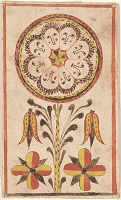
Fraktur served admirably as a reward for meritorious students (“rewards of merit”), as a bookmark or as a gift. Scholars of the subject make careful distinctions among these and define “presentation” more narrowly. They are united, however, in being more pictorial than calligraphic and generally of small size. Well drawn reward, bookmark and gift fraktur are colorful and very charming. The inspirational early Mennonite schoolmaster, Christopher Dock (1698 – 1771), is said to have originated the practice of awarding fraktur to students as part of his reliance on positive reward rather than punishment.

Love letters, lovers’ knots, valentines and holiday wishes stretch the definitional boundaries of fraktur but are often discussed together with the more conventional types. The shape and formats vary considerably and include circular valentines, pinprick works and cut-outs (Scherenschnitte). Love letters of the eighteenth century trace to European Liebesbriefe but they took on a more British character in the nineteenth century (Shelley, p. 53). This example is attributed to fraktur artist Jacob Botz.
2,036 thoughts on “Presentation Fraktur”
Comments are closed.